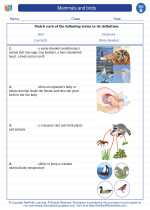Regulatory Systems
Regulatory systems in living organisms are responsible for maintaining internal stability and responding to changes in the environment. These systems help organisms maintain homeostasis, which is the balance of internal conditions necessary for survival.
Nervous System
The nervous system is the body's primary regulatory system. It is responsible for receiving and responding to internal and external stimuli. The nervous system is divided into the central nervous system (brain and spinal cord) and the peripheral nervous system (nerves throughout the body).
Study Guide for Nervous System:
- What are the two main divisions of the nervous system?
- How does the nervous system respond to stimuli?
- What is the role of the brain in the nervous system?
- How do neurons transmit signals in the nervous system?
Endocrine System
The endocrine system consists of glands that produce hormones, which are chemical messengers that regulate various bodily functions. These hormones are released into the bloodstream and affect target cells throughout the body.
Study Guide for Endocrine System:
- What are the main glands of the endocrine system?
- How do hormones regulate bodily functions?
- What are some examples of hormones and their functions?
- How does the endocrine system communicate with target cells?
Immune System
The immune system is responsible for protecting the body from pathogens and foreign substances. It recognizes and destroys harmful invaders while distinguishing them from the body's own cells and tissues.
Study Guide for Immune System:
- What is the role of the immune system in maintaining health?
- How does the immune system recognize and respond to pathogens?
- What are the main components of the immune system?
- What is the difference between innate and adaptive immunity?
Study Tips:
As you study regulatory systems, focus on understanding the interactions between these systems and how they work together to maintain homeostasis. Use diagrams and interactive resources to visualize the processes involved in regulation and response. Additionally, practice applying your knowledge to real-life examples to deepen your understanding of regulatory systems.
Good luck with your studies!
.◂Science Worksheets and Study Guides Second Grade. Mammals and birds

 Activity Lesson
Activity Lesson
 Worksheet/Answer key
Worksheet/Answer key
 Worksheet/Answer key
Worksheet/Answer key
 Worksheet/Answer key
Worksheet/Answer key
 Worksheet/Answer key
Worksheet/Answer key
 Vocabulary/Answer key
Vocabulary/Answer key
